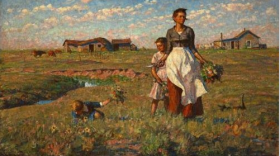On some balmy early fall days out here on the edge of the plains, it’s not hard to believe that we are not where we are. Warm southern breezes sweep all the way up from the Gulf, the sun smiles with a gentleness not seen since June, and the spacious sky reigns over everything in azure glory.
On exactly that kind of fall morning, I loved bringing my writing classes to what I call a ghost town, Highland, Iowa, a place whose remnants still exist, eight miles west and two south, a village that is no more.
What's left of Highland, Iowa, is a weather-beaten sign with a map of what once stood on the corner: a blacksmith shop, a general store, Mt. Joy Church of God, Mt. Joy's parsonage, the Rock River Lutheran Church, and its horse barn. Two churches out of five buildings. Must have been some power-lifting righteousness there.
Today, one huge old cedar and a couple dozen more youthful pines create a windbreak on the west edge of Highland's only remaining feature--a cemetery. The place is Norwegian--Hemmingson, Gunderson, and Johnson on the stones. Nothing else stands on the gently sloping hilltop where Highland once bustled, just a few tipsy gravestones and that heavy, wooden sign with the drawing of the old town.
Highland fell victim to the sad reality that 150 years ago, far more people lived out here in the country. The land was cut into 160-acre chunks back then. Today, the portions are ten times bigger.
Highland, Iowa, once sat high atop the confluence of a pair of non-descript gravel roads that still float out in four distinct directions like dusky ribbons over the undulating prairie. I bring students to Highland because what’s not there never fails to silence them. Maybe it’s the skeletal cemetery; maybe it’s the south wind through that stand of pines creating a song you don’t hear often on the treeless Plains; maybe it’s some variant of culture shock—they stumble out of cubicle dorm rooms and wake up in sprawling prairie spaciousness.
I’m lying. I know why they fall into astonishment. It’s the sheer immensity of the open land that unfurls forever before them, the horizon out where earth disappears effortlessly into sky, the rolling land. They open their eyes and there’s just plain nothing here, and that’s what stuns them into silence.
In 2001, on a morning none of them will ever forget, we stood and sat in the ditches along those gravel roads doing the assignment, just describing what we saw. No cars went by. We were absolutely alone—20 of us, on a swell of prairie on open land beneath the dome of sky.
That’s where I was—and that’s where they were— on September 11, 2001. My class and I left for Highland at about the moment the first World Trade Center tower was attacked. While the world watched in horror, we sat and looked over a landscape so immense only God could live there— and were silent, beset with awe.
No one can stay on a retreat forever, so when we returned to the college, we heard the news. All over campus, TVs blared.
But I can’t help thinking that my students, that morning, were best prepared for horror, not by our having been warned, but by our having been awed.
Every year it was a joy to sit out there and watch them try to describe the character of seemingly eternal prairie, but that year our being there on September 11, I’m convinced, was a great blessing.








